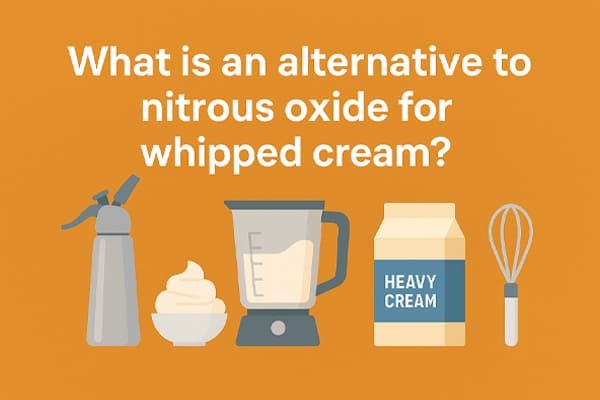Nitrous oxide is efficient—but not for everyone. Rising costs, regulations, and environmental concerns are pushing some businesses to explore alternatives. But do other options really work as well?
Viable alternatives to nitrous oxide for whipped cream include nitrogen gas, compressed air, mechanical whipping, and plant-based stabilizers. Each has its own pros and cons in terms of texture, speed, and scalability.

Before you switch your production method, it’s important to understand how each option performs—and which fits your customers’ expectations and your business model.
Can Nitrogen Gas Replace Nitrous Oxide?
Some suppliers promote nitrogen (N₂) as a cleaner, safer alternative. It’s cheaper, eco-friendly, and already used in cold brew coffee. But how does it behave in cream?
Nitrogen gas can aerate cream, but it produces a denser texture due to its low solubility. It’s suitable for low-volume or specialty products, not mass-market whipped cream.

What You Should Know:
- Lower solubility means less expansion and a heavier feel.
- Special equipment required—standard cream whippers may not be compatible.
- Texture less airy, which might not satisfy customers used to N₂O.
In some cases, nitrogen works well for niche applications. But for commercial buyers, it’s important to understand why nitrous oxide remains controversial yet effective—so you can weigh performance against regulation.
Is Compressed Air a Viable Option?
Compressed air is cheap, clean, and always available. Some businesses are experimenting with refillable systems powered by air pumps. But is it reliable?
Compressed air can be used to whip cream, but the consistency, stability, and volume are often subpar compared to nitrous oxide.

Pros and Cons of Using Compressed Air:
| Pros | Cons |
|---|---|
| Environmentally friendly | Weak aeration |
| Readily available | Low gas solubility |
| No refill cost | Not compatible with most dispensers |
| Safe and non-flammable | Poor foam texture and shelf life |
Compressed air is mostly used in experimental concepts—not in real-world production environments where consistency matters.
What About Manual or Mechanical Whipping?
This is one of the oldest methods. No cartridges, no gas, just cream and a whisk or a mixer.
Manual or machine-based whipping creates dense, stable cream with no gas. Ideal for cafés, bakeries, or eco-positioned brands.

Mechanical Whipping vs N₂O Chargers
| Factor | Mechanical Whipping | N₂O Gas Chargers |
|---|---|---|
| Texture | Dense, natural | Light, airy |
| Output Volume | Limited | High, consistent |
| Time Required | Slow | Instant |
| Operational Cost | Low | Moderate |
| Scalability | Small batch only | Commercial production ready |
Some brands use this as a marketing hook—“no propellant, all hand-whipped.” But it requires more labor and equipment, and rarely suits high-demand settings.
Are Plant-Based Stabilizers a Real Alternative?
Rather than relying on gas for aeration, some brands explore how to retain the air in whipped cream longer using additives like xanthan gum or agar.
Plant-based stabilizers can extend whipped cream shelf life, but they don’t actually create whip.

They are usually used together with gas, not as a replacement. And many customers dislike the slightly gelatinous texture that comes with them.
Why Most B2B Buyers Still Choose Nitrous Oxide
Despite the interest in alternatives, nitrous oxide remains the preferred choice for most commercial and industrial users.
Why? Because nothing matches its speed, consistency, and customer satisfaction for high-output operations.

Why N₂O Still Wins in the B2B Market
- Instant output: Ideal for busy cafés and event service.
- Consistent texture: Foamy, smooth, and widely loved.
- Low failure rate: Compatible with all standard equipment.
- High efficiency: One tank serves dozens of uses with no waste.
As a factory that supplies cream chargers globally, I’ve spoken with hundreds of B2B buyers. Most of them tried alternatives—and came back to N₂O once they faced real-world pressure to scale.
If you’re looking for a reliable, tested supply of high-purity N₂O tanks, check out our certified cream charger cylinders here.
Which Method Is Best for Your Business?
Here’s a simplified guide for choosing the right method:
| Method | Gas-Free | Speed | Texture | Best For |
|---|---|---|---|---|
| Nitrous Oxide (N₂O) | ❌ | ✅✅✅ | ✅✅✅ | High-volume B2B production |
| Nitrogen (N₂) | ✅ | ✅ | ✅ | Eco niche, cold-brew brands |
| Compressed Air | ✅ | ✅ | ⚠️ | Experimental/low-risk tests |
| Manual Whipping | ✅ | ❌ | ✅ | Artisan cafés, hand-crafted brand |
| Plant-Based Additives | ✅ | ⚠️ | ⚠️ | Texture hold, not volume creation |
Conclusion
There are several ways to whip cream—but only one is trusted worldwide for fast, scalable, professional results: nitrous oxide.
Alternatives like nitrogen, air, and manual whipping each have their niche. But if your business runs on efficiency, volume, and flavor consistency, N₂O remains the gold standard.




